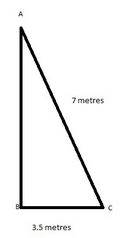
Rachit Kumar SaxenaManager-Editorial
Given by ancient Greek mathematician Pythagoras, the Pythagorean theorem is used to express the relation between the three sides of a right-angled triangle.
While the discovery of this equation has been attributed to Pythagoras in modern times, there are some who believe that the equation was actually known to Babylonians for thousands of years before Pythagoras came up with it; the only difference being that it was used to measure the area of an isosceles triangle by the people of Babylon.
What is Pythagoras Theorem?
The Pythagoras theorem states that “the area of the square of the hypotenuse in a right angle triangle is equal to the sum of the area of the square of the other two sides. Evidently, the 3 main sides of a right-angled triangle are known as the ‘Perpendicular’, ‘Base’, and ‘Hypotenuse’, where ‘hypotenuse’ is considered to be the longest since it is opposite to the 90-degree angle.
Pythagoras Theorem: Derivation
We take a right-angled triangle ABC, with ∠B being 90°, where line BD is drawn perpendicular to hypotenuse AC, giving rise to triangle ADC. On comparing ADC and ADB,
We know that ΔABC ~ ΔADB
Hence, AD/AB = AB/AC (since they’re opposite sides of both Δs)
AB2=ADxAC…….(i)
And, ΔBDC ~ ΔABC
BC2=CDxAC…….(ii)
Add equations (i) & (ii)
AB2+BC2= ADxAC+ CDxAC
AB2+BC2 = AC (AD+DC)
AD+CD = AC;
Hence, AC2 = AB2 + BC2
Pythagoras Theorem: Formula
The Pythagoras theorem formula states that -
Here ∠A is perpendicular, whereas ‘∠B is the base and ∠C is the hypotenuse.
As per definition, Pythagoras theorem is derived from -
Hypotenuse2 = Perpendicular2+ base2
a2+b2 = c2
Weightage of Pythagoras Theorem in Class 10th
Pythagoras theorem is one of the most interesting topics covered in the Geometry unit under the Class 10 ICSE syllabus alongside circles and construction. The Pythagoras theorem usually carries a total weightage of 15 marks in the question paper of 80 marks.
Illustrated Examples on Pythagoras theorem
1: A platform ladder is placed against the wall with its foot at a distance of 3.5m & the top reaching a door above the ground at a distance of 7m. Find the length of the ladder.
Solution:
Here AB is the platform and CA is the wall, where A is the window.
BC = 3.5m
CA = 7m
Using Pythagoras theorem,
AB2 = BC2+CA2
=1.87+49= 50.87
AB = 7.13m
2: Find hypotenuse of a triangle with 2 sides measuring 9 cm & 5 cm.
Solution:
Hypotenuse2 = Perpendicular2+ Base2
Hypotenuse2 = (9)2+ (5)2
= 81+25 = √106
= 10.29
3: In a right-angled triangle, the hypotenuse is 12 cm and another side is 4cm, find the third side.
Solution:
Hypotenuse2 = Perpendicular2+ Base2
\(a^{2}=b^{2}+c^{2}\)
\(12^{2}=4^{2}+c^{2}\)
\(c =\sqrt{12^{2}-4^{2}}=\sqrt{144-16}= 128 = 11.3 cm
FAQs on Pythagoras theorem
Q: What is Pythagoras theorem’s formula?
a 2+b 2 = c 2
Q: For which type of triangles can the Pythagoras theorem be applied?
Q: How can I obtain the length of a triangle?
Q: Which is the longest side of a right-angled triangle?
Q: What is the formula to find the length of a hypotenuse?
News & Updates
Maths Triangle Exam
Student Forum
Popular Courses After 12th
Exams: BHU UET | KUK Entrance Exam | JMI Entrance Exam
Bachelor of Design in Animation (BDes)
Exams: UCEED | NIFT Entrance Exam | NID Entrance Exam
BA LLB (Bachelor of Arts + Bachelor of Laws)
Exams: CLAT | AILET | LSAT India
Bachelor of Journalism & Mass Communication (BJMC)
Exams: LUACMAT | SRMHCAT | GD Goenka Test

